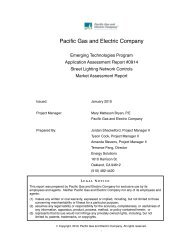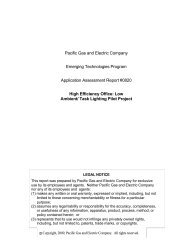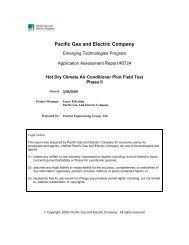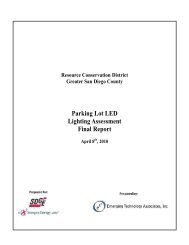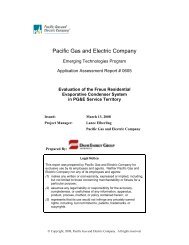Laboratory Evaluation of the OASys Indirect/Direct Evaporative
Laboratory Evaluation of the OASys Indirect/Direct Evaporative
Laboratory Evaluation of the OASys Indirect/Direct Evaporative
Create successful ePaper yourself
Turn your PDF publications into a flip-book with our unique Google optimized e-Paper software.
Since <strong>the</strong>se two measures use different denominators, <strong>the</strong>y are not additive to <strong>the</strong> overall system<br />
effectiveness (which like <strong>the</strong> indirect stage uses <strong>the</strong> intake wet-bulb depression).<br />
Reducing <strong>the</strong> supply airflow by increasing <strong>the</strong> external resistance has two effects. First, more air is<br />
diverted through <strong>the</strong> exhaust, improving <strong>the</strong> effectiveness <strong>of</strong> <strong>the</strong> indirect section. Second, when <strong>the</strong><br />
velocity decreases through <strong>the</strong> direct stage, <strong>the</strong>re is more contact time with <strong>the</strong> water, resulting in ano<strong>the</strong>r<br />
increase in effectiveness. Thus, it is not surprising that <strong>the</strong> effectiveness is highest (and thus <strong>the</strong> outlet<br />
temperature is lowest) at low airflow rates. One deceptive feature <strong>of</strong> graphing <strong>the</strong> effectiveness as a<br />
function <strong>of</strong> <strong>the</strong> supply airflow is that it appears that <strong>the</strong> three fan speeds have overlapping ranges <strong>of</strong><br />
airflows where each speed will have <strong>the</strong> highest effectiveness. The reason for this is that for a particular<br />
supply airflow, <strong>the</strong> higher <strong>the</strong> fan speed, <strong>the</strong> larger <strong>the</strong> amount <strong>of</strong> air that must be diverted to <strong>the</strong> exhaust.<br />
Figure 18 is a graph <strong>of</strong> <strong>the</strong> California Title-20 ECER, which combines <strong>the</strong> effects <strong>of</strong> airflow, power, and<br />
effectiveness. This is not a parameter that is specified by <strong>the</strong> ASHRAE test standards, but has significant<br />
interest in regards to <strong>the</strong> relative efficiency <strong>of</strong> <strong>the</strong> unit. This value is calculated in accordance with<br />
Equation 3 with fixed temperature values, even though all <strong>of</strong> <strong>the</strong>se tests were actually conducted at <strong>the</strong><br />
prescribed temperatures. The key data points <strong>of</strong> interest are those that occur when <strong>the</strong> outlet resistance is<br />
at 0.3 inches <strong>of</strong> water, and <strong>the</strong>se points are emphasized and a curve is drawn between those at different<br />
fan settings. The normal range <strong>of</strong> <strong>the</strong> ECER should be somewhere between <strong>the</strong>se two curves depending<br />
on <strong>the</strong> damper position. The shape <strong>of</strong> <strong>the</strong> curves implies that <strong>the</strong> ECER reaches its highest value at <strong>the</strong><br />
medium fan speed. It is lower at low speed due to low airflow, and at high speed because <strong>of</strong> high power<br />
consumption.<br />
The final chart <strong>of</strong> this group, Figure 19, shows <strong>the</strong> measured water consumption rate. In general, this<br />
chart shows increasing water consumption with increasing airflow, both in terms <strong>of</strong> supply airflow and<br />
exhaust airflow (as <strong>the</strong> result <strong>of</strong> opening <strong>the</strong> exhaust damper). This does not show <strong>the</strong> effect <strong>of</strong> different<br />
intake conditions, which can have a more significant impact.<br />
Fixed Outlet Resistance, Variable Intake Conditions<br />
For <strong>the</strong> next set <strong>of</strong> tests, <strong>the</strong> supply outlet resistance was kept constant at 0.3 inches <strong>of</strong> water (to provide<br />
data for <strong>the</strong> ECER calculation) while <strong>the</strong> intake conditions were varied in accordance with <strong>the</strong> selected<br />
test matrix (Table 3). For <strong>the</strong> exhaust flow, it was decided to collect data at some intermediate point<br />
between <strong>the</strong> damper open and <strong>the</strong> damper closed positions. Ra<strong>the</strong>r than resetting <strong>the</strong> damper position, it<br />
was left in <strong>the</strong> fully open position and <strong>the</strong> airflow chamber booster fan was shut <strong>of</strong>f, thus creating a<br />
resistance due to <strong>the</strong> outlet ducting that could actually be measured. Ra<strong>the</strong>r than a fixed value, <strong>the</strong><br />
exhaust outlet pressure could vary with <strong>the</strong> airflow, just as it would with <strong>the</strong> damper in one fixed position.<br />
As it turned out, this did produce exhaust airflow fractions that were about half way between <strong>the</strong> open and<br />
closed damper settings in <strong>the</strong> previous tests. Measured exhaust pressures ranged from 0.15 to 0.19 inches<br />
<strong>of</strong> water, or about half <strong>of</strong> that at <strong>the</strong> supply outlet.<br />
Figure 11 shows <strong>the</strong> resulting supply air conditions from all <strong>of</strong> <strong>the</strong> tests in this group on a psychrometric<br />
chart. The first chart shows <strong>the</strong> actual measured test data, which demonstrates that <strong>the</strong> desired test<br />
conditions could not always be maintained precisely. To better observe <strong>the</strong> effects <strong>of</strong> <strong>the</strong> variables, <strong>the</strong><br />
results were adjusted to <strong>the</strong> desired common settings using <strong>the</strong> measured effectiveness and degree <strong>of</strong><br />
humidification. The results from this second graph show a minor increase in effectiveness (or lowering <strong>of</strong><br />
<strong>the</strong> supply air temperature) as <strong>the</strong> fan speed is decreased. Of greater interest is that as <strong>the</strong> outside air<br />
temperature increases for a fixed wet-bulb temperature, <strong>the</strong> supply air temperature decreases and capacity<br />
improves. This is <strong>the</strong> opposite <strong>of</strong> what happens with a conventional air conditioner, which looses<br />
capacity and efficiency with increasing ambient temperature. The summer comfort zone conditions<br />
would not be met with this system if it were already humid outside, but only in terms <strong>of</strong> <strong>the</strong> indoor<br />
humidity. The supply air temperatures were all at or below <strong>the</strong> comfort zone conditions.<br />
491-06.12.doc 16




